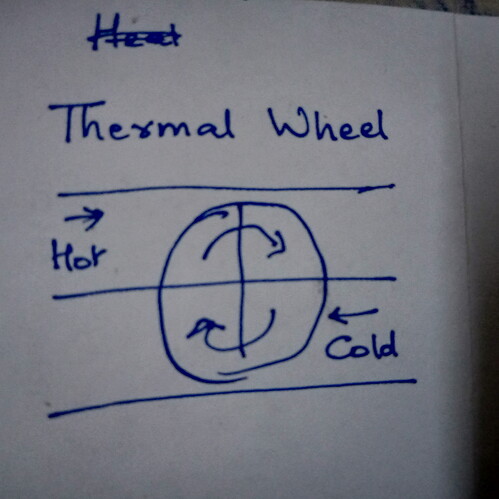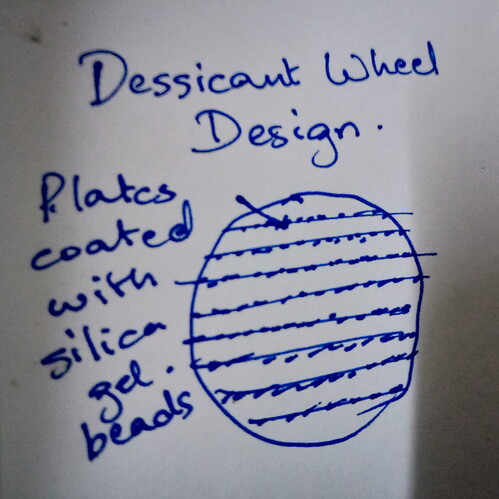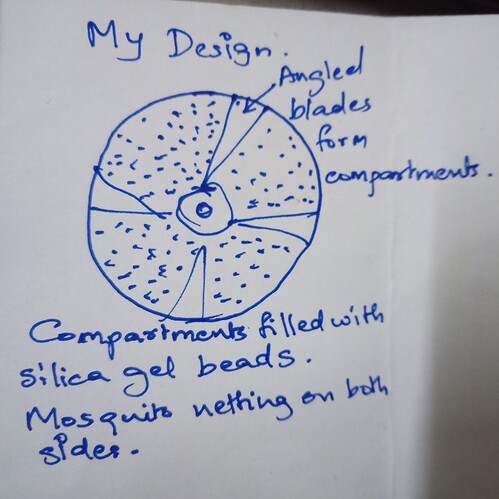I will have waste heat in the form of hot air from another project. Living in humid Mumbai, one of my objectives was to make a dehumidifier and use the waste heat as the hot air channel. Current designs rely on a motor to turn the dessicant wheel. I started wondering whether the hot air itself could power it. After all, a thermal wheel is almost identical and powered by hot air, so… a design challenge.
My thoughts so far.
Thermal Wheel
The flow of the hot air, as well as the heating of the compartments on one side and cooling on the other create rotation in the wheel, which has one side of the axis hot and the other cool.
Dehumidifier using dessicant wheel:
The hot air dehydrates the dessicant and the cool air rehydrates it. As the wheel is rotated, the device acts as a humidity pump. But there appears to be no movement generated (this is based on youtube videos. I have not seen a dessicant wheel in person and don’t know if it moves due to the air temperature differential)
Current design of dessicant wheels:
This is how the dessicant wheels are designed. The wheel has a lot of thin plates coated with dessicant (usually silica gel unless industrial systems). The gap between the plates is very small forcing air passing through the wheel into maximum contact with the dessicant. This is fairly elaborate to fabricate as well.
My design for a dessicant wheel:
For the dessication to happen, unlike the thermal wheel, the air must pass through the dessicant wheel and it must rotate into the lower chamber. So my guess is that the orientation of the wheel probably cannot be changed to be similar to a thermal wheel without losing efficiency. However, if we look at a wind turbine, angled blades should be able to harness the hot air movement to rotate the wheel without external power being provided.
Also, in my design, I have not bothered with the thin plates coated with dessicant. Instead, the chambers formed by using the angled blades to create compartments will simply be filled with silica gel beads and the air will pass through them and get dehydrated or rehydrated according to the appropriate air flow.
The evil genius of this design (if it works) will be fairly effective harnessing of ambient heat to get some work (dehumidification) done. While I am planning to use the waste heat from my peltier cooling gadget, I can think of several sources of hot air that could be harnessed. Notably ventilation from a refrigerator in the kitchen or a desktop computer.
Some points:
- The airflow is not likely to be very powerful, so it is important that the wheel turn really easily. Some ideas for making such wheels that came to mind involved usb fans with broken motors (these turn notably easily and we don’t need the motor to work) glue mosquito netting across the edges of the blades on both sides, fill in silica gel and we are in business. Bonus is easy mounting facility too. A more custom sized wheel could be fabricated around a fidget spinner bearing. The lab having a 3D printer, a perfect design to maximize all intended utility could be devised. On a still larger scale, a bicycle wheel could be used by simply taping adjacent spokes together to create “blades” and optimizing the rotation.
- A fan may be needed for the cool side if the power of the airflow from the hot side is not adequate to turn the wheel or a suitable air flow of ambient air cannot be found. Good news is that the fan will also help boost the turning of the wheel.
- The hot air exiting the device will have to be vented outside the area to be dehumidified, or the humidity will simply be returned to the room rendering the device pointless.
- The wheel does not need to turn too fast. So as long as the air currents manage to turn it, the device will work. No matter how slowly.



